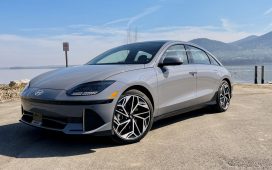The US saw record gains in fuel efficiency last year, but it still falls short of what’s needed to meet fast-approaching deadlines. Thanks to their love of large vehicles, American automakers have fallen behind their competitors when it comes to getting more miles per gallon of gas.
Real-world fuel economy in model year 2022 rose slightly to 26 miles per gallon, according to the EPA’s latest Automotive Trends Report. That’s a 0.6mpg increase from the year before, which is apparently “more than double the annual rate of improvement in fuel economy” over the past nine years, according to the EPA.
But while the agency celebrates the incremental improvement, there’s still a long way to go to reach the fuel efficiency standards the US has set for itself. By 2026, vehicles are supposed to reach an average of 49 miles per gallon. The National Highway Traffic Safety Administration (NHTSA) finalized that rule back in 2022, and earlier this year, it proposed even higher standards for cars made between 2027 and 2032.
By 2026, vehicles are supposed to reach an average of 49 miles per gallon
That leaves a seemingly massive gap between US aspirations and fuel efficiency today. Fortunately, tracking progress isn’t as simple as comparing those goals to the data the EPA released in its report yesterday. Data on real-world fuel economy, which the EPA evaluated, tends to be lower than compliance data — which is what’s used in NHTSA’s rules.
The estimated real-world data is measured using lab tests that better reflect road conditions and the way people drive. Numbers for real-world fuel economy tend to be about 25 percent lower than official compliance data might show, according to Dan Becker, director of the Safe Climate Transport Campaign at the Center for Biological Diversity.
Taking that into consideration, automakers still need to make more progress if they want to reach 49mpg within a couple of years. Fuel efficiency is supposed to increase by 8 percent each year for model years 2024–2025 to keep in line with that goal.
American car companies — excluding Tesla — will need to work extra hard considering they lag behind brands from other countries. Average fuel economy for Ford, General Motors, and Jeep and Dodge parent company Stellantis last year ranged between about 21mpg and 23mpg. They’re lagging behind foreign automakers like Hyundai and Honda, which are at the top of the list, having reached around 29mpg.
There are clear culprits behind the disparity. The growing popularity of trucks and SUVs is dragging the fuel economy of American-made cars down. That has broader health and environmental consequences, too.
Supersized passenger vehicles burn through more gas than smaller cars, which also means that they create more tailpipe pollution that worsens air quality and causes climate change. Larger electric vehicles are problematic, too, since they create more particle pollution from the wear and tear of roads and tires.
Fortunately, the emission rate for planet-heating carbon dioxide from new vehicles still dropped 3 percent to a record low last year, the EPA reports. But trucks and SUVs managed to chip away at some of that progress.
“The long-term trend away from sedan/wagons and towards vehicle types with lower fuel economy and higher CO2 emissions has offset some of the fleetwide benefits that otherwise would have been achieved from the improvements within each vehicle type,” the EPA report says.
“American companies have been stupid and short sighted,” Becker says. “They would rather continue to sell gas guzzlers, which they have been making money on, than switch to advanced technology vehicles, which are the future.”
Aside from making electric vehicles, Becker points out that companies have been slow to adopt other fuel-saving technologies. Turbochargers can make cars more fuel-efficient by making use of waste heat, for instance. But this technology only made its way into roughly 37 percent of large manufacturers’ 2022 model year vehicles. Luxury automakers had the highest adoption, with turbocharging in nearly all of BMW’s vehicles and 90 percent of Mercedes’ 2022 fleet. Stellantis had the lowest rate of adoption at just 13 percent.
When it comes to meeting fuel efficiency goals, “all the auto companies have the technology to do this,” Becker says. “This is auto mechanics, not rocket science.”












